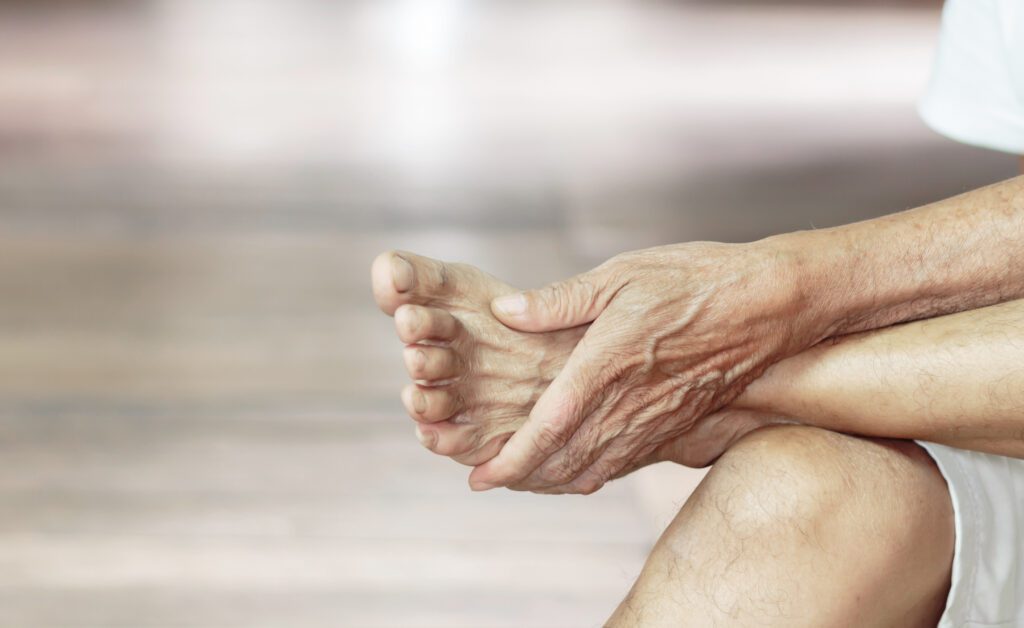Foot Care For Diabetics

There’s a lot of things about your health to keep track of when you have diabetes — from diet to checking glucose levels and taking medications. Foot care can feel low on the priority list, but it should be an essential part of everyday self-care.
Diabetes is a serious issue that affects 34.2 million Americans — that’s about 1 in every 10 people in the United States. About half of all diabetics in the U.S. suffer from nerve damage as a result, according to the CDC.
Because diabetes causes nerve damage and issues with blood circulation, your feet are at a higher risk for damage. Diabetics are at a higher risk for bunions, corns, blisters, and ulcers.
Potential nerve damage from diabetes means you won’t feel these foot issues, but it also means that you won’t notice when you have cuts, blisters, and sores on your feet. With elevated glucose levels in your blood, that can quickly lead to nasty infections.
Here’s what you need to know (and what to watch for) about caring for your feet when you’re a diabetic.
INSPECT YOUR FEET DAILY
Checking your feet for issues should be an everyday activity. It’s especially important if you know you have nerve damage.
Inspect your feet for cuts, sores, blisters, and other irregularities. Be mindful to check your toenails to ensure you’re not getting an in-grown nail. Also check for warm spots on your feet, which can be an indication that a blister or an ulcer is forming.
If you discover corns or calluses, don’t try to remove them yourself. Visit your podiatrist for help. Similarly, if you’re unable to reach your feet, ask your podiatrist or doctor for help trimming your nails.
Check in between your toes as well as the tops, sides, soles, and heels of your feet. If you’re unable to inspect your entire foot, try using a mirror or asking a loved one for assistance.
WASH YOUR FEET DAILY
As part of your daily foot check, make sure that you’re washing and cleaning your feet every day.
Use warm (not hot) water, and use a soft cloth or sponge. Avoid soaking your feet as it can cause your feet to dry out.
Completely dry your feet by patting your skin dry — don’t rub them to dry them. Use a moisturizer or petroleum jelly on your feet to prevent them from drying out and cracking. Don’t apply moisturizer or jelly between your toes as it can lead to infection.
AVOID GOING BAREFOOT
Because many diabetics suffer from nerve damage, it’s important to never walk around barefoot — even in your own home.
Make sure to always wear shoes or slippers (or socks at the very least) to prevent injuries from stepping on sharp objects, which could cut your feet. Check the inside of your shoes before putting them on and shake them out to ensure there are no pebbles or small items that could cause cuts or abrasions to your feet.
Avoid wearing tight-fitting shoes or shoes with open toes, like flip-flops or sandals, which can leave you open to injury.
Always wear socks with your shoes. Change your socks daily, and wear socks that are made from a natural fiber like wool. Natural fibers are breathable, while synthetic fibers can dry out your feet.
WEAR THE RIGHT SHOES
Wearing the correct shoes is important for everyone, but it’s especially important for diabetics.
Because of circulation issues associated with diabetes, shoes that are too tight can cause additional damage.
When buying new shoes, try them on at the end of the day when your feet are at their largest. Make sure to wear the same type of socks you normally wear when trying on new shoes.
GET YOUR FEET CHECKED AT ABOITE PODIATRY TODAY
Visit your podiatrist on a regular schedule, and ask to have your feet checked during each visit. Regular visits will help identify complications early and may help prevent them from becoming a problem.
Even seemingly minor cuts, abrasions, and calluses can become extremely problematic and worsen quickly for people with diabetes.
Schedule an appointment with one of our doctors today by calling 260-436-3579.
